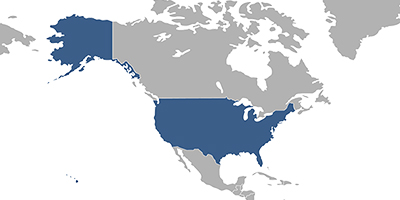USA

International Country Code:
USTime Zone:
UTC/GMT -05:00Currency:
United States dollar ($) (USD)PCT national phase entry in the USA
PCT national phase entry in the USA
- Patent fees
Fees associated with the US PCT national phase entry as well as other patent fees are available in the fee calculator.
- Deadline for PCT national phase entry in the USA
The time limit for the PCT national phase entry in the United States of America is 30 months from the date of priority. The national stage can be revived if a petition and fee are filed within two months.
- Filing requirements in the US
The official language of the US patent application is English. If the international application is filed in any other foreign language, the English translation thereof must be provided after the filing and in response to an Official Notification that will specify the period of time allowed, usually two months from the date of the notice. A further extension is also possible on condition that the corresponding fees are paid.
To obtain the date of filing, a PCT national phase patent application in the US should contain:
- copy of the international application, unless previously communicated by the International Bureau (should include translation if the international application is not in English);
- executed oath or declaration (may be submitted after 30-month deadline);
- national fee;
- Information Disclosure Statement (prior art details).
Legalisation of the Power of Attorney is not required. There is no set deadline for submitting a POA when entering the US national stage of a PCT application.
- Examination of a PCT national phase patent application in the USA
A request for substantive examination is not necessary; it occurs simultaneously with entering the US PCT national phase. It is possible to request an accelerated examination under PPH.
- Information Disclosure Statement
The applicant is obliged to disclose by way of an Information Disclosure Statement (IDS), any information that could be considered to be material to a determination of patentability of the claimed invention. This duty extends to an applicant’s legal representative and anyone involved in the registration of the application. The information can be of any type, and includes, but is not limited to, prior art. The duty continues until a patent is issued or the application is abandoned. An intentional failure to submit an IDS may result in a later declaration of the patent as unenforceable.
If the IDS is filed within three months from the national phase entry in the US or before the first office action, no government fee is required to be paid for the filing of an IDS.
In case any information contained in the IDS was first cited in communication from a foreign patent office in a counterpart foreign application more than 3 months prior to filing of said IDS, or was otherwise known to the applicant or applicant’s representative more than 3 months prior to filing the IDS, additional official fees must be paid.
- Novelty grace period
In the USA, the novelty grace period constitutes 12 months before the US filing date or before the priority date, if:
- the disclosure was made by the inventor or by a person who obtained the information from the inventor (directly or indirectly);
- the disclosure occurs after public disclosure of the same invention by the parties set forth above.
- Grant, validity term and maintenance fees
The official issue fee for a patent in the USA should be paid within three months from the mailing of the Notice of Allowance. Annual fees are due at years 3.5, 7.5 and 11.5 from the patent issue date and may be paid within a 5-month period preceding the due date without a surcharge. Late payment with a surcharge is possible within 6 months after the expiry of the period set forth above. Early payment is not available. A patent in the USA is valid for twenty years from the US filing date.
- Duration of registration procedure
It takes an average of 32 months from US filing date to granting of a patent.
- Utility Model
Utility model protection is not available under the legislation of the USA.
- Representation by a patent attorney
For foreign applicants, it is recommended to perform the PCT national phase entry in the USA through a US registered patent attorney or agent.
- Note
Online Database for US Patents.
The above information was verified on 06.08.2025
Please contact us if the above information is not in conformity with U.S. IP Laws